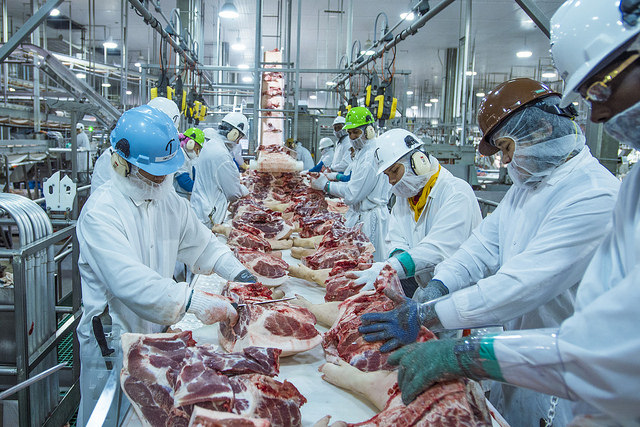



Weekly beef and dairy digest: USMCA gets its first test and China bans more Australian beef
US beef exports continue their steep decline and the USDA issues its assessment of SE Asia's diary prospects.Updates from the global beef industry
US beef exports show sharp drop over the last month
US net sales of 3,000 metric tonnes (MT) reported for 2020 were down 78 percent from the previous week and 80 percent from the prior 4-week average. Increases primarily for Japan (3,300 MT, including decreases of 400 MT), Mexico (1,700 MT, including decreases of 100 MT), Canada (1,300 MT), China (800 MT, including decreases of 300 MT), and Indonesia (400 MT), were offset by reductions primarily for South Korea (4,600 MT) and Hong Kong (1,000 MT).
For 2021, net sales of 12,000 MT were primarily for South Korea (7,200 MT), Japan (1,600 MT), Hong Kong (1,200 MT), China (1,000 MT), and Mexico (900 MT). Exports of 18,200 MT were up 10 percent from the previous week, but unchanged from the prior 4-week average. The destinations were primarily to Japan (5,100 MT), South Korea (4,400 MT), Mexico (2,600 MT), China (1,800 MT), and Hong Kong (1,400 MT).

China suspends beef imports from Australia’s Meramist Pty Ltd
The sixth Aussie supplier to be banned from shipping beef to China is Australia’s Meramist Pty Ltd. China gave no reason for the suspension. Australia issued a warning on trade, saying uncertainties from its souring ties with China and the lingering impact of an earlier drought will push down the value of its agriculture exports.
The value of shipments is set to decline 7 percent in 2020-21 to the lowest level in five years, according to government forecaster Abares. But China’s trade with Australia continued to grow strongly, despite the trade dispute. China’s exports to Australia were up 20.6 percent last month, while imports from Australia rose by 8.3 percent.
Strong Chinese agriculture purchases likely to continue in 2021
An outlook report from ING Economics says: “According to government data, China’s pig herds in October were 26.9 percent higher YoY, and with this strong growth, demand for animal feed has grown, which has been supportive for corn and soybeans.
"Finally, over the years we have seen China draw down inventories in certain commodities. The domestic corn balance has tightened over the years, with flat production, and continued demand growth, and so there is a need to rebuild stocks.
"The outlook for corn demand remains constructive in the longer term, particularly given China’s aim of implementing a nationwide 10 percent ethanol mandate, which was meant to be implemented in 2020, however, it was suspended due to tightening corn stocks and limited production capacity for ethanol.
"Given China’s environmental/ carbon reduction targets, the mandate will likely be implemented at a later stage, which should be supportive for corn demand.”
Chinese meat imports remain strong
China imported 775,000 MT of meat last month, up 1.8 percent from October. The customs data didn’t break down the imports by product, but the bulk was pork. Through November, China’s meat imports this year stood at 8.95 MMT, up 63 percent from the same period last year.
US inspectors at meatpacking plants told to remain at work after exposure to COVID-19
Meat-packing employees are complaining USDA isn’t doing enough to keep them safe from COVID-19. Inspectors also said USDA is no longer notifying employees of where cases crop up or how many workers have tested positive.

Updates on the global dairy industry
Canadian dairy industry faces USMCA challenge
The US Trade Representative informed Canada will file enforcement action over its rules for US dairy imports. Canada said it is fully within its rights to apply tariff-rate quotas (TRQs), which follow the rules laid out in the U.S.-Mexico-Canada (USMCA) trade pact that went into effect in July.
“Canada’s administration of its dairy TRQs is in full compliance with its commitments under the new NAFTA,” Youmy Han, spokesperson for Canada’s Trade Minister Mary Ng, said.
“Our government will always stand up for our dairy farmers and a strong supply management system in Canada, which ensures the viability of our family farms and the vitality of our rural areas.”
Canada has 15 days to engage regarding any complaints about perishable items, such as milk, and 30 days to respond for other products. If the countries fail to reach a deal through consultations, the complainant can request the creation of a dispute settlement panel to examine the issue.
USDA details prospects for growth in US dairy exports to southeast Asia
The demand for dairy products in southeast Asia (SEA) is expected to grow in the coming decades, creating opportunities for exporters in the United States and other countries, said USDA. Top dairy suppliers to the region include New Zealand, the European Union (EU), the United States, and Australia.
A study examined the prospects for growth of US dairy exports to the SEA region, US competitors in these markets, and the price sensitivity of SEA demand for the four top US products imported by the region. In addition, this study explained how the US potential to gain or lose market share varies from one SEA country to another and among products.
Trends in market share and sensitivity to prices for US dairy products vary across countries and products. By examining trade patterns and using a statistical modelling approach, this study showed SEA total dairy imports have grown in recent years, from $3.8 billion in 2006 (valued in constant 2018 US dollars) to $6.3 billion in 2018.
SEA dairy imports from the United States grew from $401 million in 2006 (valued in constant 2018 US dollars) to $738 million in 2018. Over this period, the United States moved from the fourth to the third largest SEA dairy product supplier, behind New Zealand and the EU.
USDA overview of Western Europe
German observers report that the seasonal valley of milk production has been passed through and production is increasing. Components are also reported to be increasing. A trend of generally increasing milk production is expected to continue until about May 2021.This general pattern is also expected in most of the primary Western European milk producing nations.
EU-UK Brexit negotiations remain on-going. If no further agreement is reached soon, on 1 January 2021, products entering the EU from the UK will be subject to full customs as well as sanitary and phytosanitary (SPS) procedures, according to Eucolait. Requirements for EU products entering the UK will be phased in over a 6-month period from January to July 2021 (in accordance with the UK "Border Operating Model").

USDA overview of Eastern Europe
Ukraine exports of primary dairy products January – September 2020 were below January – September 2019. Results include butter, -43.7 percent; SMP, -27.0 percent; WMP, -59.6 percent; and cheese, -21.1 percent, according to CLAL data made available to USDA.
News from Oceania
Australia - Dairy producers in Australia are concerned with the heat wave which has covered much of the country. With summer about to begin, sources note that temperatures in some interior areas have reached 113 degrees already.
Typically, the hottest temperatures are recorded in January. Hundreds of wildfires have already been reported in New South Wales, Victoria and Queensland. Recalling the massive fires last year which generated smoke that circled the earth there is great apprehension as to whether this early extreme heat is a harbinger of things to come.
New Zealand - October 2020 New Zealand milksolids reported by DCANZ and CLAL, 267,666 million kg, are up 0.28 percent from October 2019 milksolids, 266,907 million kg. October 2020 milk production, 3,240 million MT, is up 0.84 percent from October 2019, 3,213 million MT. Seasonal milksolids (June – October 2020) are up 1.84 percent YOY. Total seasonal milk production through October leads last season by 2.07 percent.
US dairy industry updates
Despite many months to sign up for US dairy programme, industry group urges extension
The National Milk Producers Federation is calling for USDA to extend its dairy sign-up period. Sign-up for the 2021 Dairy Margin Coverage (DMC) past the current Friday deadline is being asked of USDA. The NMPF’s letter urges USDA Secretary Sonny Perdue to provide a 30 January deadline.
“Extending the DMC deadline to the end of next month will allow farmers to better focus on the turbulent marketing environment we now expect to see in 2021, once we are through the upcoming holiday season,” NMPF President and CEO Jim Mulhern said. As of last Monday, 45 percent of the nation’s nearly 25,000 dairy operations with established production history had signed up for 2021 coverage.
US dairy retail market at a glance
Even in early December conventional ice cream in 48-64 ounce containers is the second most advertised dairy product. The weighted average advertised price, $3.20, is down $0.30 from last week.
Butter in one-pound packages has an average price of $3.04, up $0.01 from last week. Milk in half gallon containers is the most advertised organic dairy item. The national weighted average advertised price for organic half gallons is $3.72. The national weighted average price for conventional half gallon milk is $2.57, resulting in an organic price premium of $1.15.

USDA weekly US dairy report
Fluid milk report
Class I retail demand is healthy throughout the country, as more people are staying at home. That said, food service, primarily due to limited school district ordering, is spotty. Milk production is moving higher throughout the country. The cooler weather and longer nights are having a positive impact in regards to milk production upticks.
In general, there is plenty of milk for all processing needs. Cheese producers reported spot prices from $4 to $8 under Class III in the Midwest. Cream is growing in availability for all uses, as well. FOB cream multiples are 1.15-1.33 in the East, 1.10- 1.32 in the Midwest, and 1.05-1.24 in the West.
Dry products report
Low/medium heat non-fat dry milk (NDM) prices shifted higher this week. Export and domestic demand have tightened stocks. Market conditions are bullish. High heat NDM prices are steady to higher.
Dry buttermilk prices moved up across the country. Market participants report the weaker US dollar is pushing more buttermilk powder (and other dairy powders) into Mexico and other export markets. Buttermilk powder market tones are bullish for the near term.
The dry whole milk price range widened. Requests from chocolatiers are strong as the winter season is in full swing. Dry whey prices are firming. Market participants report export demands are solid. In addition, dry whey interests in the domestic market are healthy. Whey protein concentrate 34 percent prices shifted up, as well. Stronger prices for other dairy proteins have been supportive of WPC 34 percent prices. Lactose prices are steady to lower. Market conditions are unsettled. Prices for acid casein are mixed. Rennet casein prices are steady.
Read Jim Wyckoff's analysis of the global pig industry on The Pig Site and see updates on the broiler industry on The Poultry Site.
TheCattleSite News Desk
IMPORTANT NOTE: I am not a futures broker and do not manage any trading accounts other than my own personal account. It is my goal to point out to you potential trading opportunities. However, it is up to you to: (1) decide when and if you want to initiate any traders and (2) determine the size of any trades you may initiate. Any trades I discuss are hypothetical in nature.
Here is what the Commodity Futures Trading Commission (CFTC) has said about futures trading (and I agree 100%): 1. Trading commodity futures and options is not for everyone. IT IS A VOLATILE, COMPLEX AND RISKY BUSINESS. Before you invest any money in futures or options contracts, you should consider your financial experience, goals and financial resources, and know how much you can afford to lose above and beyond your initial payment to a broker. You should understand commodity futures and options contracts and your obligations in entering into those contracts. You should understand your exposure to risk and other aspects of trading by thoroughly reviewing the risk disclosure documents your broker is required to give you.



